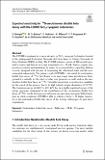| dc.contributor.author | Dompè, V. | |
| dc.contributor.author | Adams, D. Q. | |
| dc.contributor.author | Alduino, C. | |
| dc.contributor.author | Alfonso, K. | |
| dc.contributor.author | Avignone, F. T. | |
| dc.contributor.author | Azzolini, O. | |
| dc.contributor.author | Bari, G. | |
| dc.contributor.author | Bellini, F. | |
| dc.contributor.author | Benato, G. | |
| dc.contributor.author | Beretta, M. | |
| dc.contributor.author | Biassoni, M. | |
| dc.contributor.author | Branca, A. | |
| dc.contributor.author | Brofferio, C. | |
| dc.contributor.author | Bucci, C. | |
| dc.contributor.author | Camilleri, J. | |
| dc.contributor.author | Caminata, A. | |
| dc.date.accessioned | 2022-06-21T13:00:48Z | |
| dc.date.available | 2022-06-21T13:00:48Z | |
| dc.date.issued | 2022-06-13 | |
| dc.identifier.uri | https://hdl.handle.net/1721.1/143484 | |
| dc.description.abstract | Abstract
The CUORE experiment is a ton-scale array of
$$\hbox {TeO}_2$$
TeO
2
cryogenic bolometers located at the underground Laboratori Nazionali del Gran Sasso of Istituto Nazionale di Fisica Nucleare (INFN), in Italy. The CUORE detector consists of 988 crystals operated as source and detector at a base temperature of
$$\sim 10$$
∼
10
mK. Such cryogenic temperature is reached and maintained by means of a custom built cryogen-free dilution cryostat, designed with the aim of minimizing the vibrational noise and the environmental radioactivity. The primary goal of CUORE is the search for neutrinoless double beta decay of
$$^{130}\hbox {Te}$$
130
Te
, but thanks to its large target mass and ultra-low background it is suitable for the study of other rare processes as well, such as the neutrinoless double beta decay of
$$^{128}\hbox {Te}$$
128
Te
. This tellurium isotope is an attractive candidate for the search of this process, due to its high natural isotopic abundance of 31.75%. The transition energy at (866.7 ± 0.7) keV lies in a highly populated region of the energy spectrum, dominated by the contribution of the two-neutrino double beta decay of
$$^{130}\hbox {Te}$$
130
Te
. As the first ton-scale infrastructure operating cryogenic
$$\hbox {TeO}_2$$
TeO
2
bolometers in stable conditions, CUORE is able to achieve a factor
$$>10$$
>
10
higher sensitivity to the neutrinoless double beta decay of this isotope with respect to past direct experiments. | en_US |
| dc.publisher | Springer US | en_US |
| dc.relation.isversionof | https://doi.org/10.1007/s10909-022-02738-4 | en_US |
| dc.rights | Creative Commons Attribution | en_US |
| dc.rights.uri | https://creativecommons.org/licenses/by/4.0/ | en_US |
| dc.source | Springer US | en_US |
| dc.title | Expected sensitivity to 128Te neutrinoless double beta decay with the CUORE TeO2 cryogenic bolometers | en_US |
| dc.type | Article | en_US |
| dc.identifier.citation | Dompè, V., Adams, D. Q., Alduino, C., Alfonso, K., Avignone, F. T. et al. 2022. "Expected sensitivity to 128Te neutrinoless double beta decay with the CUORE TeO2 cryogenic bolometers." | |
| dc.contributor.department | Massachusetts Institute of Technology. Department of Physics | |
| dc.identifier.mitlicense | PUBLISHER_CC | |
| dc.eprint.version | Final published version | en_US |
| dc.type.uri | http://purl.org/eprint/type/JournalArticle | en_US |
| eprint.status | http://purl.org/eprint/status/PeerReviewed | en_US |
| dc.date.updated | 2022-06-19T03:11:48Z | |
| dc.language.rfc3066 | en | |
| dc.rights.holder | The Author(s) | |
| dspace.embargo.terms | N | |
| dspace.date.submission | 2022-06-19T03:11:48Z | |
| mit.license | PUBLISHER_CC | |
| mit.metadata.status | Authority Work and Publication Information Needed | en_US |
